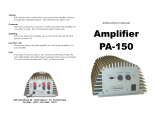
5
HKTS 9/16
ENGLISH
HKTS 210SUB Rear-Panel Connections
HKTS 210SUB Rear-Panel Connections
Phase switch
0.
: The Phase switch
0
determines whether the HKTS 210SUB’s
piston-like action moves in and out in phase with the satellite speakers. If the
subwoofer were to play out of phase with the satellite speakers, the sound waves
produced by the subwoofer could be canceled out, reducing bass performance and
sonic impact. This phenomenon depends in part on the relative placement of all the
speakers in the room. In most cases the Phase switch
0
should be left in the
NORMAL
position. However, it does no harm to experiment, and you can leave the
Phase switch
0
in the position that maximizes bass response and impact.
Bass Boost switch
1.
: Set this switch to
ON
to enhance the HKTS 210SUB’s
low-frequency performance. Set this switch to
OFF
for normal low-frequency
performance.
Power On Mode switch
2.
: If this switch is set in the
AUTO
position and the Power
switch
8
is set to
ON
, the HKTS 210SUB will automatically turn itself on when it
receives an audio signal and will enter the standby mode once no audio signal has
been received for about 15 minutes. When this switch is set in the
ON
position, the
HKTS 210SUB will remain on whether or not it is receiving an audio signal. An LED
on the HKTS 210SUB’s top panel indicates whether the subwoofer is in the on or
standby state:
When the LED glows white, the • HKTS 210SUB is turned on.
When the LED is not illuminated, the • HKTS 210SUB is in standby mode.
When the Power switch
8
is set to
OFF
, the LED will not be illuminated, no
matter what setting the Power On Mode switch
2
is in.
Subwoofer Level control
3.
: Use this control to adjust the HKTS 210SUB’s volume.
Turn clockwise to increase the volume; turn counterclockwise to decrease the
volume.
Input Mode switch
4.
: When this switch is in the “Normal” setting, the input signal
from the Line-Level L/R In connectors
7
is active. When this switch is in the
“LFE” setting, the input signal from the Line-Level LFE In connector
6
is active.
External Trigger input
5.
: Use the mini-plug of the supplied combination LFE and
trigger cable to connect the External Trigger input to the trigger output of another
compatible component. Whenever a trigger signal between 3V and 30V (AC or DC)
is detected by the HKTS 210SUB, its amplifier will turn on. The HKTS 210SUB’s
amplifier will turn off after the trigger signal ceases. (This will occur even when the
Power On Mode switch
2
is in the
AUTO
position.)
Line-Level LFE In connector
6.
: The signal from this connector bypasses the
subwoofer’s internal low-pass crossover. When you’re connecting the subwoofer
to the dedicated subwoofer output of a receiver/processor that has its own low-
pass crossover network, use the Line-Level LFE In connector
6
and set the
subwoofer’s Input Mode switch
4
in the “LFE” position.
Line-Level L/R In connectors
7.
: The signals from these connectors pass through
the subwoofer’s internal low-pass crossover. When you’re connecting the
subwoofer to the preamp or subwoofer outputs of a receiver/processor that
does not have its own low-pass crossover network, use both Line-Level L/R In
connectors
7
and set the Input Mode switch
4
in the “Normal” position. If
your receiver/processor has only one subwoofer output, you can use either the L or
R connector.
Power switch
8.
: Set this switch in the
ON
position to turn the HKTS 210SUB on. The
subwoofer will then either be on or in standby mode, depending on the setting of
the Power On Mode switch
2
.
Power cord (non-detachable)
9.
: After you have made and verified all subwoofer
and speaker connections described in this manual, plug this cord into an active,
unswitched electrical outlet for proper operation of the HKTS 210SUB. DO NOT plug
this cord into the accessory outlets found in some audio components.















